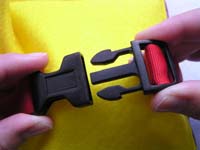FINE MOTOR CO-ORDINATION
FIDDLY FINGERS
Fine motor activity books:This is a series of hands-on fabric activity books to develop a child's small intrinsic finger muscles and their coordination. The aim of these fine motor books is to develop a child's independence when getting dressed and when tackling demanding everyday tasks such as drawing and writing. These books contain many activities involving buttons, press studs, Velcro, hooks and eyes, zips and many others.
All books in this series come with a long list of fine motor activities that the adult can do at home or at school with the child in order to continue the development of those fine finger muscles and coordination.
R850 Code:3050

|

|

|
BOOK 1:
This book is the first in a series of fine motor activity books especially for children with very weak finger muscles. It is a very basic beginner book containing simple large buttons, large press studs, a large zip, a large hook and eye and easy to pull off velcro, a squeaker and beads to count.
- In this book, children will button and unbutton flowers, remove shapes from Velcro and stick them in the correct place next to a similar shape (shape matching activity), remove wheels from press studs and stick them in the correct place on the tractor, unzip a bag, remove beads on a string, count them and then close the zip again, "catch" a fish by hooking it with a large hook and eye.
- The fish is removable and has a squeaker to exercise those finger muscles and for fun.
- A long list of other fine motor activities is included at the back of the book.
- On each page there are questions that the adult can ask the child regarding the activity on that page like counting, comparing and teaching colours etc.

|

|

|
R850 Code:3052

|

|

|

|
BOOK 2:
This Book 3 is the most tricky of the fine motor books in this series. The child will need stronger finger muscles and coordination to be able to manipulate these different fasteners. This book involves lacing, tying bows, opening quick release buckles, unscrewing a lid, manipulating a lobster clasp, an open-ended zip and squeezing a cord lock toggle to open and close a bag.
- In this book the child will lace a boot and then tie a bow.
- Open a quick release buckle, unscrew the lid of a pot, count the discs inside, screw the lid on again and then close the buckle.
- Three fish can be caught by opening a losbter clasp and hooking the fish. Each fish that is caught is placed on the fish bowl with a different method of attachment such as velcro, a popper and a button.
- The child can open the open-ended zip of the jacket. Then the belt must be buckled on the dress inside and then the zip can be closed again.
- An apple is unzipped to show a caterpillar inside on a ribbon. The apple is zipped up again once the child has discovered another tiny surprise inside the apple.
- A bag can be opened by releasing the cord being held by the cord lock toggle. The shapes inside the bag are identified and counted and then the bag is closed again by squeezing the toggle.
- On each page there are questions that the adult can ask the child about activities on that page.
- On the back page of the book is a removable card with a lot of further activities you can do at home or school to further strengthen a child's fine finger muscles and co-ordination.

|

|

|

|

Copyright (c) Lynette Rudman 2007
All International Copyright laws apply
All rights reserved. No part of this publication may be reproduced, stored in a retrieval system, or transmitted in any form or by any means, electronic, mechanical, photocopying, recording or otherwise, without the prior permission of the author.
